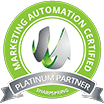A lot of Managed Service Providers (MSPs) struggle with getting a steady flow of new leads across all of their marketing efforts. For some, it's becoming a growing concern. Especially given the trend of new IT providers cropping up and offering what amounts to an "Uber" alternative to the traditional MSP's "Taxi" service.
To really understand how to get the most out of your marketing efforts, you first need to accept that there is no "easy button" for marketing. It’s a lot of hard work. And the moment it starts to feel easy is the moment the rug is about to be pulled out from under you. There is no quick fix, and no program or product you can buy to compensate for doing the work. Marketing is a process, and one you need to follow through on.
This process starts with leads. A lead is a person or business that has expressed an entry-level interest in what you have to offer. A lead is not necessarily someone who is ready to buy into your services today. It may be someone who simply has questions, and has now given you an opportunity to show them a little of what your company is about. Failing to recognize these small openings as a potential future prospect will result in your MSP missing out on new business.
Positioning your company to get as many leads as possible is the job of your marketing team. If your marketing team can get you in front of more people, you can close a lot more business. However, it's important to remember that marketing is not sales. Marketing takes an entirely different mindset, focusing on a one-on-many approach instead of the one-on-one approach that is crucial for sales. Marketing is meant to cast a wide net to draw more people in, giving you more interested parties for your sales teams to close with.
How does a professional marketing department accomplish this? By focusing on five key areas.
#1 - Your Website.
First and foremost, your website needs to look professional, and it needs to be clean and easy to navigate. Your site needs to clearly show what your business is about, where you operate, and who your clients are. A small business should be able to see at a glance that you offer support for small businesses.
The top priority of your site needs to be converting a visitor into a prospect. Whether they're downloading a whitepaper, requesting a consult, or running a free security scan, you want them to take an interest in something you have to offer.
Most of all, your site needs to focus on the business owner. Highlight the challenges you know they are facing, and what benefits you can offer them if they sign up for your services. How will you make their life easier? How will you help them achieve goals? Decrease costs? Overcome technology challenges? Provide answers to these questions, and focus on the benefits of your services instead of simply listing your services.
You also need to make it easier for people to connect with you. Contact information on websites can often be difficult to find, and that can quickly discourage visitors. Have contact numbers or email addresses throughout the site, and include your contact form in as many places as you can. Under no circumstances should you include Captcha on these forms. It's annoying to your prospects, and can deter them just as quickly as hard to find contact information. Instead, use a service like Form Stack to filter out spam.
Something else to keep in mind is the fact that most technology decisions are made by the rank-and-file people - administrators and executive assistants. CEOs and the like may have the final say in these decisions, but it's the administrators that will be dealing with you. Remember that if you can't impress them, their opinion holds more weight than your resume does.
#2 - Fill Your Funnel.
Your funnel is the starting point of your marketing efforts for each of your leads. You can purchase leads lists, harvest lists off of the Internet, attend business-to-business networking functions, or use social media or any number of other tools to find names to add to the top of your funnel.
Why is this step so important? Experts agree that is takes 125 warm leads to generate a single conversation or meeting. That means 125 leads that showed some potential interest in your company. This is why your funnel needs to touch across all of your marketing efforts, and it needs to be measured. Put lead scoring to work for you. By placing a points value on a prospect's interest based on a number of factors, you can clearly see where your immediate focus needs to be. If you can do this, you will never run out of opportunities to start building relationships.
#3 - LifeCycle Marketing.
It's critical that you keep engaging with, and offering information and education to leads in your funnel. You need to position yourself as a subject matter expert, and continue to give leads reasons that they should be working with your company. This starts by your company becoming a great source of information. Include good information on cyber threats or other important topics on your blog, in your email campaigns, and in your newsletter.
Drip email campaigns are a great way to engage with leads over a set period of time, and keep educating them and feeding them good information. These campaigns can also help you judge the level of interest a lead has based on how many emails they opened. Tools like Infusionsoft allow you to personalize outgoing emails, making the recipient feel as though you've taken time out of your day to connect with them instead of pumping out mass emails. This can do wonders for the success of your email campaigns.
Most importantly, focus on making strong, meaningful connections with top prospects. If you don't have time to make calls and follow up on leads, make time. All of your marketing efforts will go to waste if you're just sitting back and waiting for the phone to ring. You cannot wait for new business to come to you on its own.
#4 - Social Media.
The next step is to connect with prospects on social media. Make good use of LinkedIn, Facebook, Twitter, Goggle+, YouTube, or any other platform you can think of. Social media not really your thing? Learn to love it. Get online and start building connections, because social media is a huge part of modern marketing efforts. Keep in mind that people do business with the person first, the business second, and the product or service third. It can all come down to getting to know them on a personal level, and making the right impression.
There are huge opportunities on social media. For example, LinkedIn is more than a social media platform; it’s a research platform. It’s a great place to find names for your funnel, and it's as easy as doing a quick search for CEOs in your area.
Make a point of connecting with everyone, because everyone is important. Networking means involving yourself on some level with as many people as possible, in as many industries and professions as possible. Adopting this culture within your company can be the difference between succeeding, and struggling.
#5 - Never Forget About The Old Fashioned Way Of Doing Things.
Direct mail is still a successful tool, and high scoring prospects are a great target for direct mail campaigns. You already have their attention, and this is another opportunity for you to capitalize on it. Direct mail works best when you add that special touch. Put forth the effort to make your correspondence feel personal to the reader, just like your emails.
Whitepapers, stories of success, informational brochures, promotional materials, special offers, free reports, and print newsletters are all great options for material to be sent out as direct mail. Go ahead and send out anything you think the market needs to know. The possibilities are endless.
There are a few other things to consider that are equally as important, such as business-to-business networking. This in particular is a critical piece of your marketing efforts. These networking events are not an environment for prospecting. They are an opportunity to build networking contacts who can then refer prospects to you down the road through connections of their own.
Telemarketing remains an important marketing tool, and has the ability to generate leads. Trade shows can provide great opportunities as well. Webinars are a fantastic tool for sharing information and getting your name out there. After the initial "broadcast", the webinar can be made available for download, and provide a source of material for blog posts and drip email campaigns, offering a different tip from the webinar each week.
Seminars offer amazing opportunities. You can contact CPA groups, law groups, medical managers, or anywhere your company can find a target audience. Something to consider regarding participating in a seminar as opposed to hosting a seminar is that instead of filling seats, providing food, and taking care of all of the other details, all you have to do is show up.
At the end of the day, it's all about filling the top of your funnel. Marketing is a lot of very hard work. It can be overwhelming, and it can be discouraging. Which is why you need to have a partner who knows what they are doing. A partner like Ulistic. You're not accomplishing anything productive by outsourcing to someone you feel you need to constantly check in on and keep on track. What you need is the assurance that your company is not just in good hands, but in the hands of true professionals.
Interested in learning more about how Ulistic can help your MSP achieve stratospheric success? Contact us at {email} or {phone} to get started.



